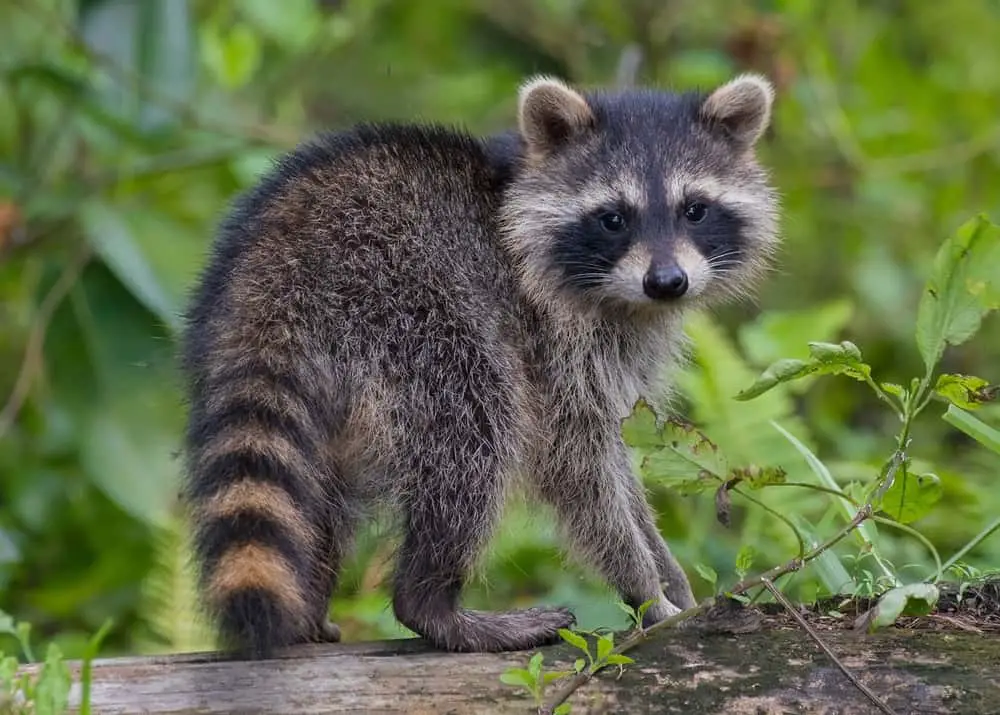
Raccoons live throughout North and South America, Europe, and Asia in forests and mountain ranges. Noted for their distinctive ringed tail and black facial mask, they are extremely intelligent creatures. Studies have shown they are adept problem solvers and remember the solutions for years.
They are a member of the suborder Caniformia, a group describing dog-like carnivores. With a weight range of 10 to 60 pounds, Raccoons are omnivorous. Their diet consists of insects, fish, small animals, and plants.
Raccoons use their front feet like hands and are able to manipulate small objects. It is common for them to wash their food before eating. The average lifespan in the wild is three years, although they can survive much longer in captivity.
Raccoons are not solitary. Males and females live together in sex-specific groups consisting of three or four individuals. Their primary defense against predators is to climb trees.
Table of Contents
- Skunks
- Sun Bears
- Coatis
- Red Pandas
- Cacomistles
- Badgers
- Anteaters
- Olingos
- Sloth Bear
- Ring Tailed Cat
- River Otters
- Olinguitos
- Weasel
- Kinkajous
- Raccoon Dog
Skunks
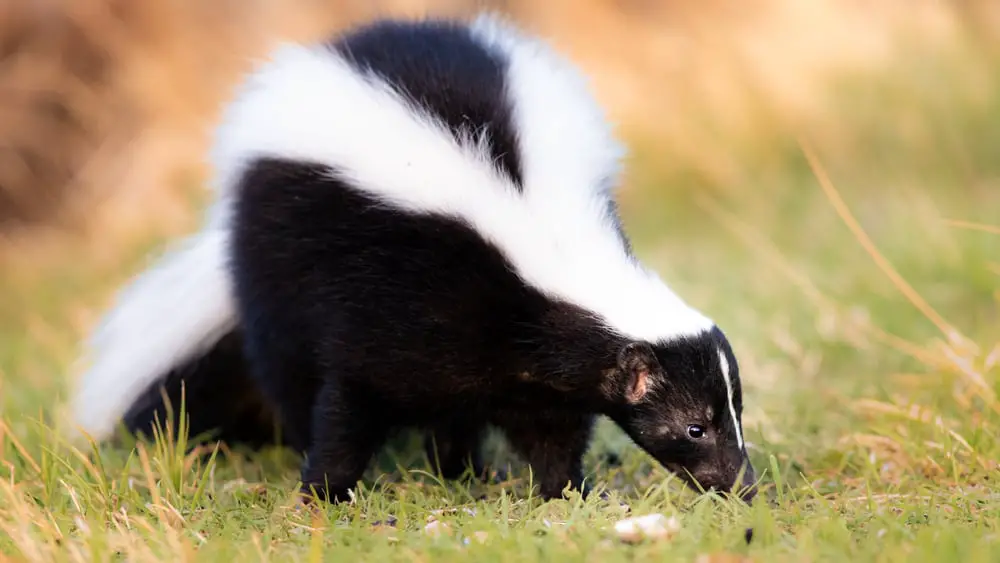
Skunks are best known for their ability to ward off threats by releasing a foul-smelling fluid from their anal glands. Their closest relative is the Stink Badger. There are 11 different species of skunk, most of which are found in North and South America.
Full-grown, they are about the size of a small dog. Skunks have very poor eyesight, instead of relying on their sense of smell and hearing to forage and detect predators.
Like the Raccoon, skunks are nocturnal and omnivorous. They eat a variety of small mammals, reptiles, fish, bird eggs, and some types of plants.
Skunks differ from raccoons in that they are more solitary. Socialization only occurs during mating. They also live longer in the wild, with the average lifespan being ten years.
Sun Bears
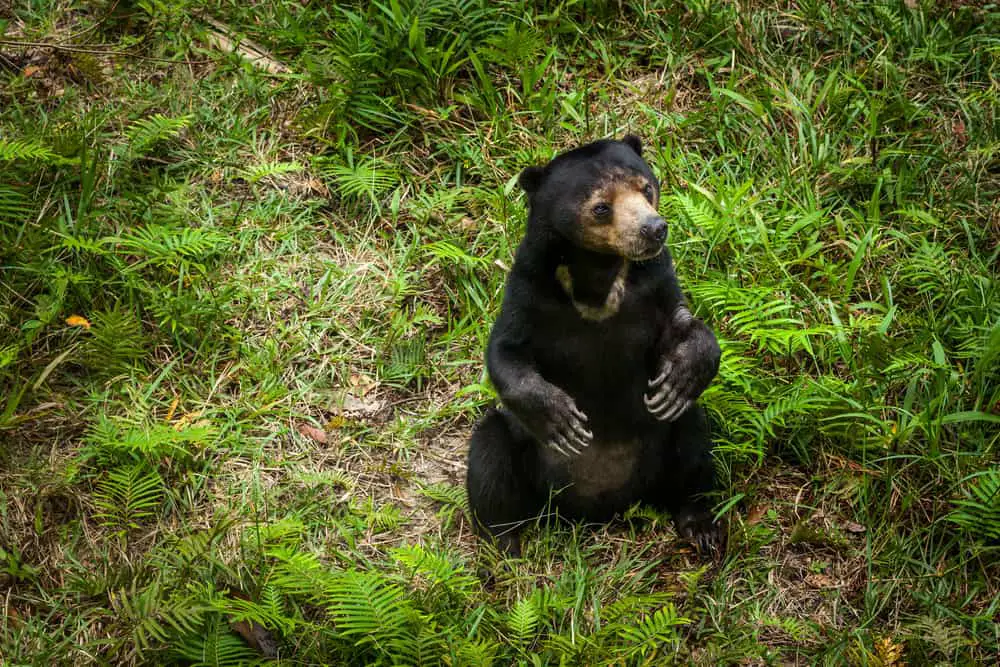
Sun Bears live in Asia among the tropical rainforests and mangroves. It is the smallest bear in the family Ursidae. The trend towards solitary living but is sometimes seen in pairs.
Their coloration is mostly dark except for a patch of cream-colored fur on their chest. Although they are usually docile, they will stand on their hind feet in an aggressive display of behavior when threatened.
Sun Bears, like raccoons, have an affinity for climbing. They have been known to scale trees as high as 23 feet. They are omnivores and are noted for their high level of intelligence.
Sun Bears are much larger than raccoons, weighing around 143 pounds in adulthood. They are active during the day and at night. Special adaptations, such as long tongues, and razor-sharp claws, help them raid beehives found in tree canopies.
Coatis
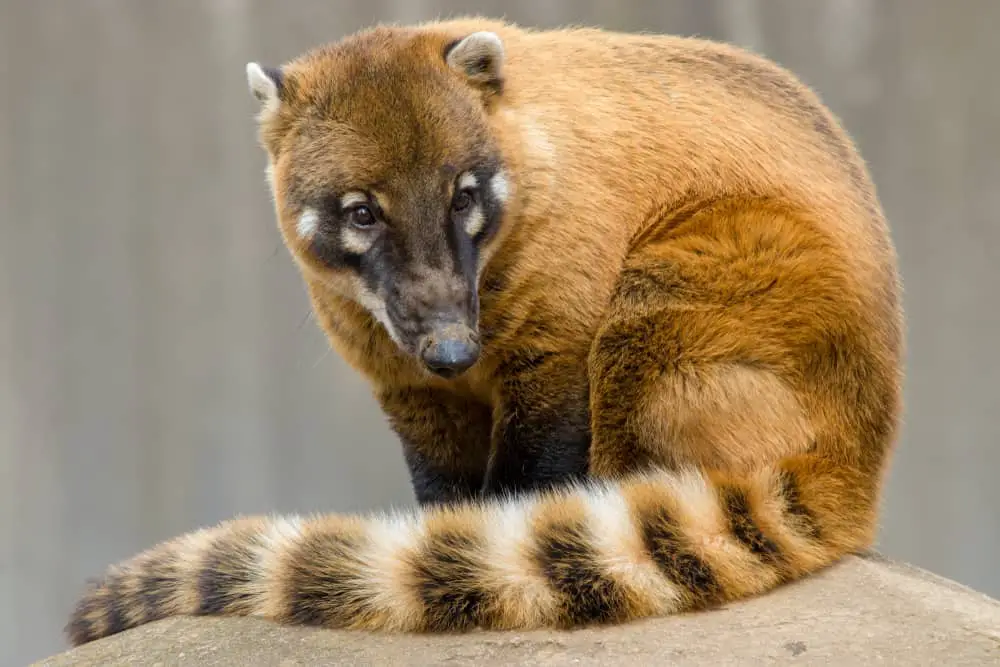
There are four species of Coati in North and Central America. Typically, they are found in woodlands and desert savannas at altitudes below 9,850 feet. They are omnivores but are noted for their unique habit of eating tarantulas.
Coatis communicate with each other using verbal sounds and scents. They have special musk glands under their bellies that aid in identifying each other.
Raccoons and Coatis are from the same taxonomic family. They are similar in appearance and the Coati is sometimes called a “Hog Nose Raccoon.” The tail of both animals has a distinctive ring pattern that completely encircles them.
Unlike their raccoon relatives, Coatis are diurnal. They forage and hunt during daylight hours. When traveling in groups, Coatis will hold their tails in the air so they can be seen over the tall grass.
Red Pandas
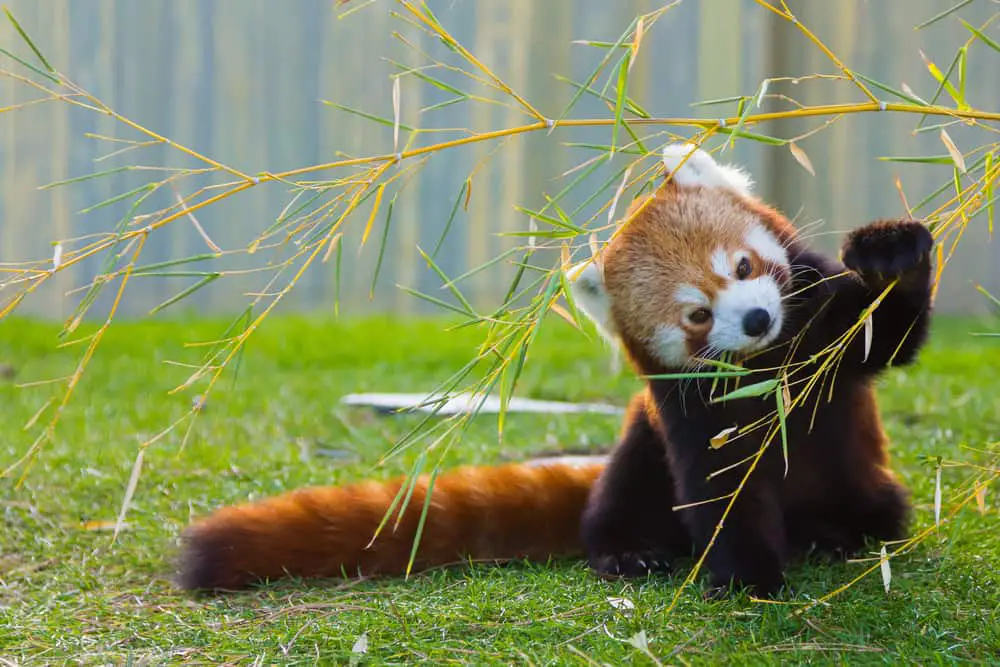
Red Pandas are dog-like mammals found in China and in geographical pockets throughout the Himalayas. They live in forests that feature dense stands of bamboo. The Red Panda is nearly extinct, with only around 10,000 animals left in the wild.
As the name suggests, Red pandas are mostly red and weigh an average of 16 pounds. Being highly territorial creatures, they mark their boundaries with musk and urine.
Red Pandas belong to the raccoon family Procyonidae. With their ringed tail, they are often mistaken for raccoons. They are also solitary and nocturnal.
Red Pandas are the only animals in this taxonomical family that are not truly omnivorous. They eat bamboo exclusively and spend almost all of their waking hours engaged in feeding.
Cacomistles
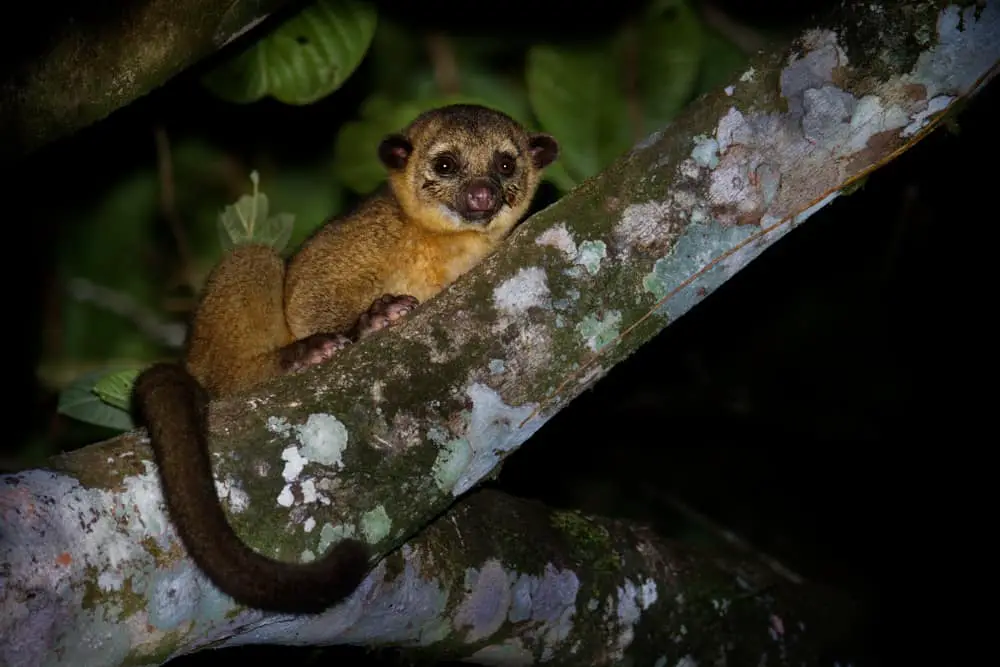
Cacomistles are small omnivores that inhabit parts of Mexico and Central America. They prefer woodland areas that offer a dense tree canopy with a water source in close proximity.
Weighing an average of two pounds, Cacomistles have bodies covered in brown, grey or black fur. Their tails are proportionally sized to match their body length, with each measuring around 18 inches. They have a lifespan of around five years in the wild.
Cacomistles share the raccoon’s masked face and ringed tail. They feed on the same types of foods, with small reptiles, rodents, birds, and crustaceans comprising most of their diet.
While Raccoons will sometimes den in trees, Cacomistles are almost entirely arboreal. They live alone and have a territorial range of 50 miles
Badgers
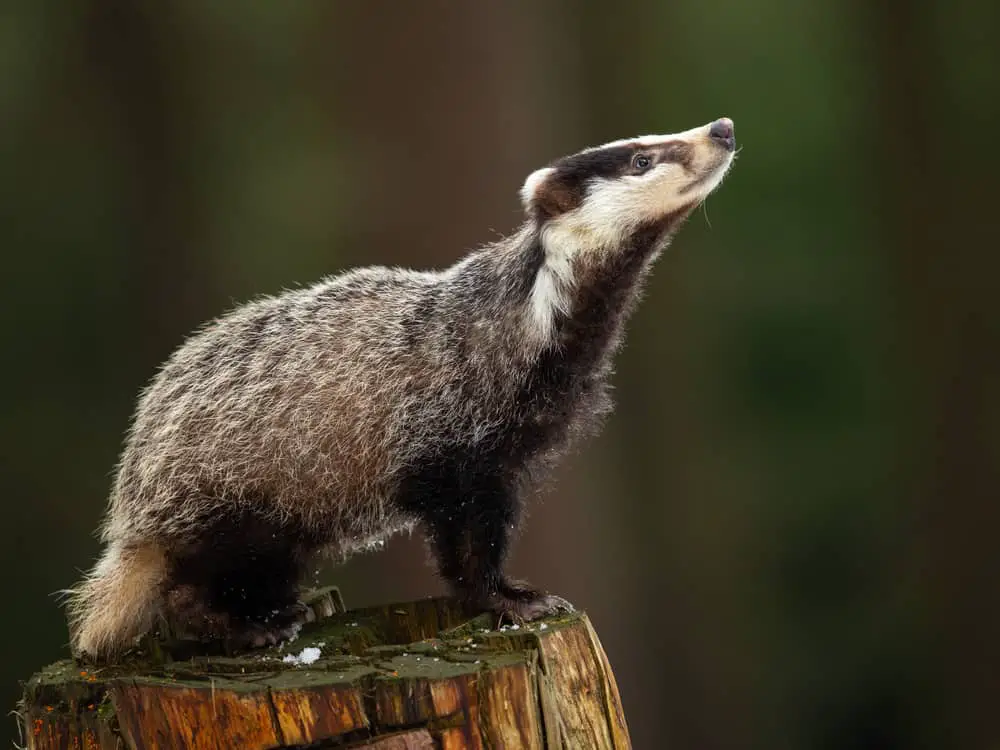
Badgers belong to the suborder Caniformia and there are 11 distinct species in the family Mustelidae. They are found throughout North America, Europe, and Asia, with one species being native to Africa.
Their diet consists of small beetles, grubs, and other insects. They have short legs and wide bodies that are well suited to digging. The average weight range is 20 to 24 pounds.
Badgers share the raccoon’s preference for forests and meadows. They can also be found in more urban areas and live in clans of four or five individuals.
Instead of utilizing naturally made dens, like raccoons, badgers burrow in tunnels. Their front feet are not dexterous and are primarily used for digging.
Anteaters
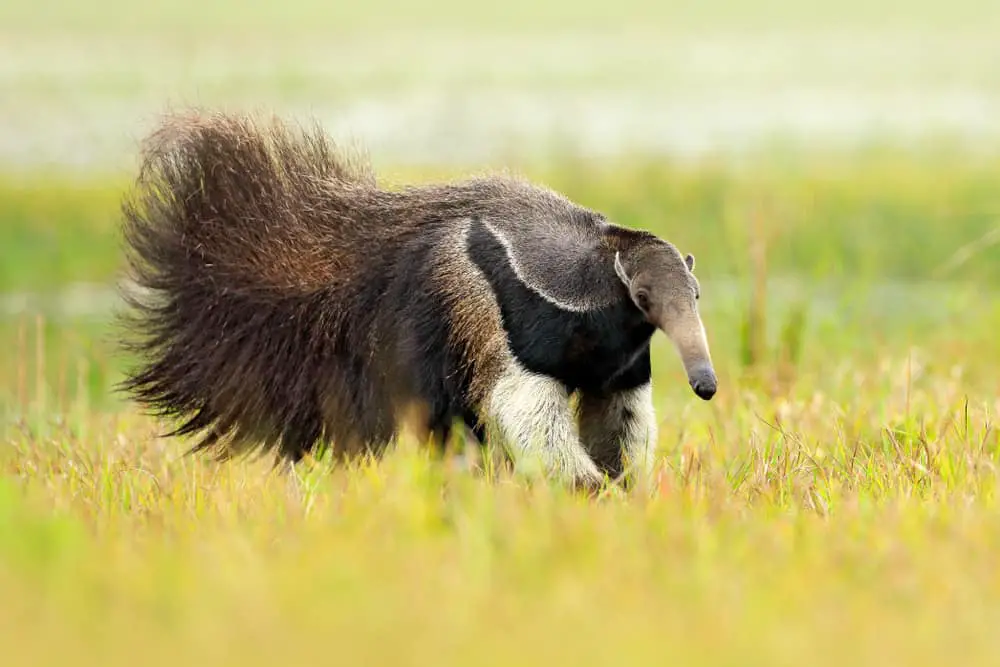
Anteaters are medium to large-sized terrestrial insectivores. They have long tube-like noses and long tongues that can stretch the entire length of their heads.
Some species have prehensile tails that help them climb and hang on the branches of trees. They have the lowest body temperature of all known mammals, averaging 91 degrees Fahrenheit.
Like the highly adaptable raccoon, they are capable of living in many different biomes. They also share similar types of non-retractable claws for digging and climbing.
Anteaters belong to the suborder Vermilingua, meaning “animals with long tongue.” They have a special adaptation on their tongues, called filiform papillae, that secretes mucus to aid in gathering large amounts of tiny insects at one time.
Olingos
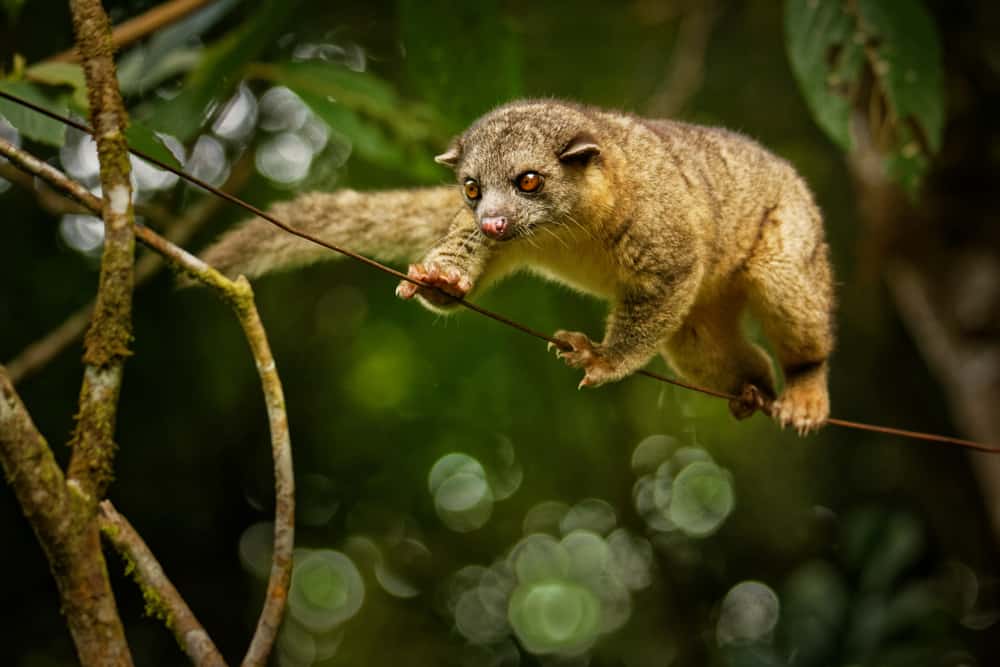
Olingos live in the jungles of Peru and Nicaragua. They are reclusive and nocturnal. Social habits among Olingos vary depending on what activity they are engaged in. The den and forage alone but are known to travel in small groupings.
Their coloring is usually grey or brown with a band of white or yellow fur around their neck. The back legs are considerably longer than the front legs. Adults weigh about four pounds.
Olingos have a bushy tail with rings, much like the raccoon and other members of the family Procyonidae. Although they are listed as omnivores, they mostly eat fruit.
Their primary means of defense is more similar to the skunk than it is the raccoon. They possess anal scent glands that secrete a noxious odor when threatened.
Sloth Bear
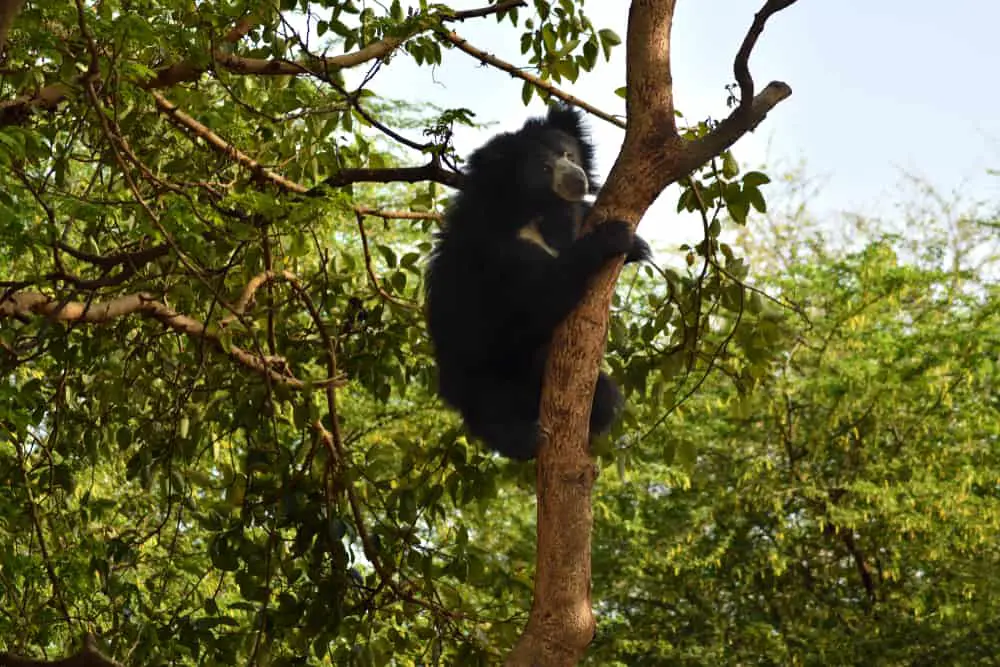
Sloth Bears are covered in thick black fur with a single white marking across their chests. They are distinguishable from other species by the presence of a long, stretchy lower lip that can extend to cover their nostrils.
They have no upper teeth and weigh 150 to 300 pounds. Found in the tropical and savanna biomes of Sri Lanka, India, and Nepal, the wild population has dwindled to around 20,000 individuals.
Sloth Bears are classified as omnivorous, like the raccoon, but they prefer to eat ants and termites in addition to plants, fruits, and honey. They are avid climbers and most active at night.
While both raccoons and Sloth Bears will nest in trees, the latter sleeps in the open laying on broken limbs. Sloth Bears carry their babies on their backs and can seal their nostrils closed when eating insects.
Ring Tailed Cat
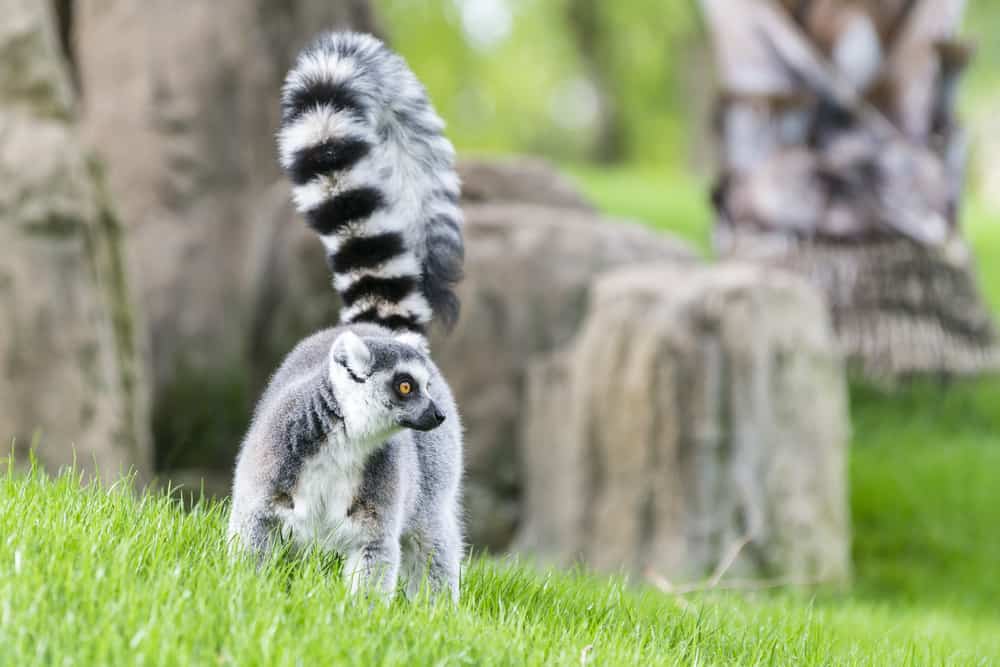
Ring Tailed Cats are dark brown or black Caniforms that weigh between one and three pounds. They have long whiskers, black facial masks, and long ringed tails.
Predominantly found in the southwestern United States and Mexico, they live in rocky desert habitats close to a water source. Den locations include canyons, caves, and abandoned mines.
Ring Tailed Cats are very close relatives of raccoons and share many of the same characteristics. They are excellent climbers and eat the same foods.
Unlike raccoons, they are solitary except for breeding season. They are also more nimble and can scale gaps between canyon walls.
River Otters

River otters live on virtually every continent, except Australia and Antarctica. They can adapt to life in any biome other than desserts, mountain ranges, and arctic climates.
There are 13 species of river otters with a weight range between two and 90 pounds. They all feature long bodies covered in fur with webbed feet. They live in small groups.
As dog-like mammals, raccoons and river otters shared a single common ancestor 29 million years ago before they diverged into separate taxonomic families. They eat the same foods and their droppings are nearly indistinguishable to all but the most skilled trackers
River otters differ from raccoons in that they are aquatic or semi-aquatic. They den in or around streams and rivers.
Olinguitos
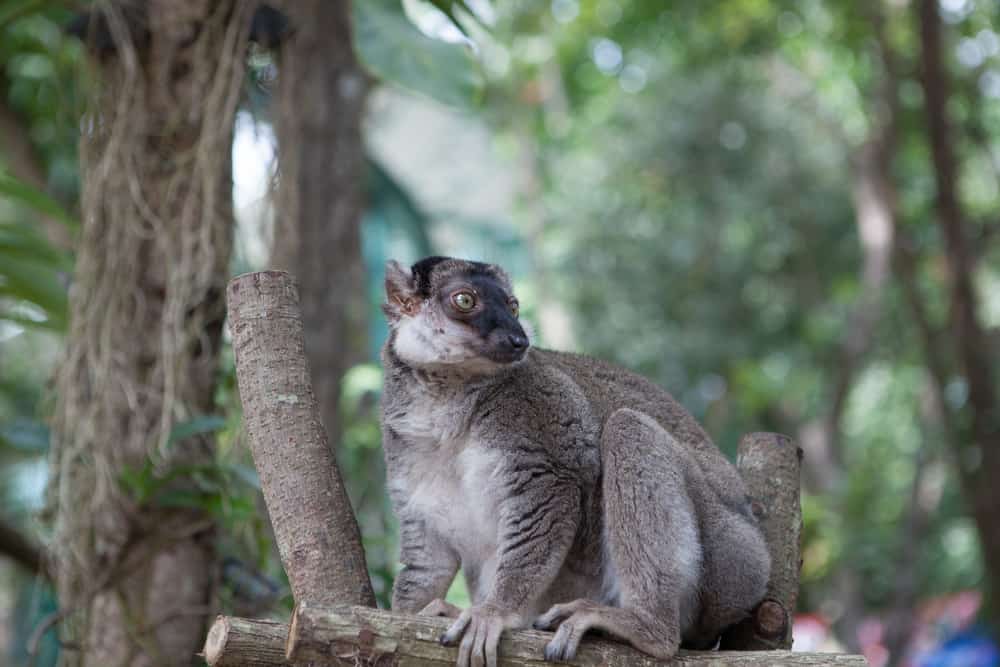
Olinguitos are a newly discovered genus found in the Andes Mountain ranges of Columbia and Ecuador. Their habitat is tropical evergreen forests with low cloud cover and high humidity.
Weighing about two pounds, they are covered in thick reddish-brown or orange and have long tails. They give birth to a single baby each season.
Olinguitos and raccoons are nocturnal omnivores. Like their carnivorous ancestors, they possess poorly developed pairs of carnassial teeth to aid in eating the flesh of small animals.
Instead of denning like raccoons, Olinguitos build nests in trees. They are capable of jumping limb-to-limb, similar to squirrels.
Weasel
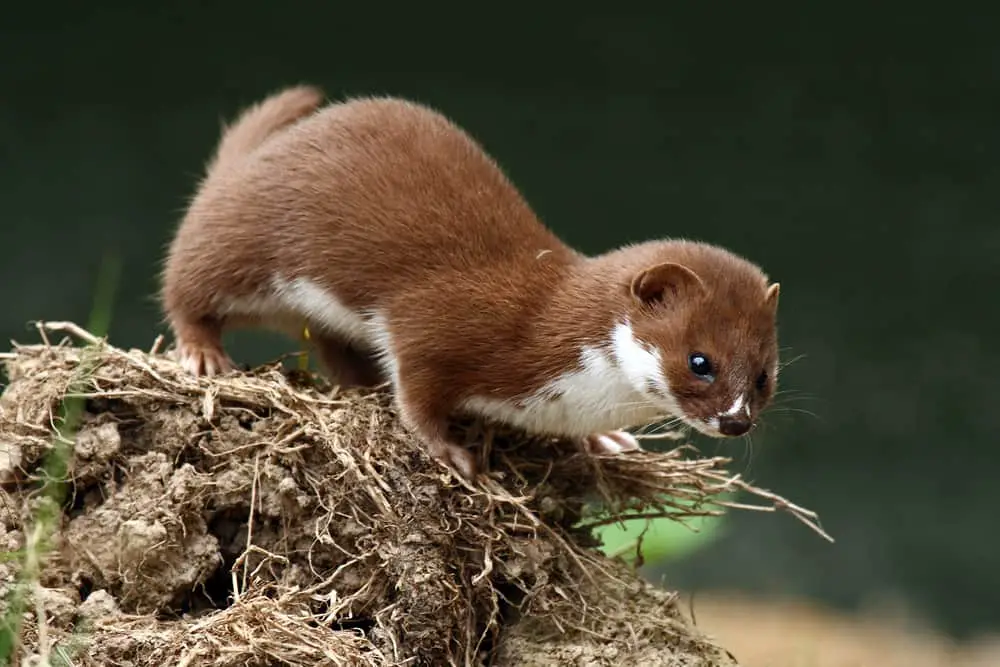
Weasels are found all over the world. They will live in forests, pastures, and hedgerows, as long as the water is close and prey is plentiful.
Averaging about seven inches long, they have long brown coats and lighter underbellies. Nesting in empty burrows and under rocks, their territorial range is 20 acres.
DNA evidence places the weasel as the closest relative to the raccoon. They are also adept climbers and do not hibernate during winter.
Weasels differ from raccoons in that they are voracious hunters, consuming 40 percent of their body weight in prey daily. They are considered pests by farmers because of their habit of stealing chickens and eggs.
Kinkajous
Nicknamed the “honey bear,” kinkajous are small nocturnal animals found in the tropical rainforests of Mexico and Bolivia. They have smooth brown coats and long tails. Kinkajous are secondary consumers, with 90 percent of their diet being fruit. The remaining ten percent is made up of flowers, nectar, insects, frogs, and bird eggs.
Kinkajous change dens almost daily and sleep in family groups. They can live up to 40 years in captivity.
Hailing from the family Procyonidae, their most direct relative is the Red Panda. They are not as dexterous as raccoons but they are able to grasp fruit with their front feet.
Kinkajous are much smaller than raccoons, weighing between one and three pounds and measuring less than two feet long. They cannot retract their claws and have considerably smaller territorial boundaries.
Raccoon Dog
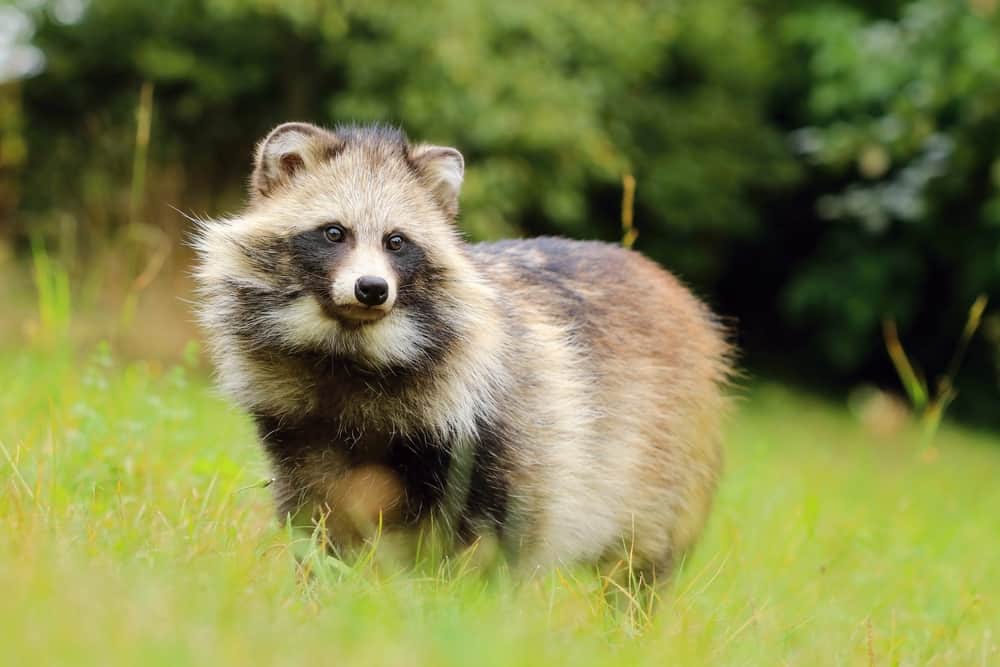
Raccoon Dogs are small canids from the suborder Caniformia. They are native to China. Their diet is comprised of other small animals, insects, plants, and eggs.
They are the only type of canid that hibernates during winter when food is scarce. Weighing between ten and 20 pounds, they lose one-quarter of their body mass during this period.
Raccoon Dogs have coats and markings that closely resemble their namesake, the American Raccoon. They are able to climb trees and live an average of five years in the wild.
Despite the Raccoon Dog’s uncanny resemblance to the raccoon, they are closer to true foxes. Males and females are monogamous and raise their young together. This habit is critical to their survival, with pups typically dying if the male is not present.



